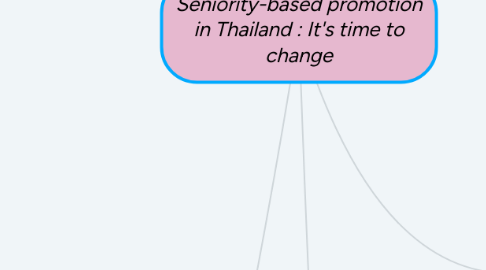
1. Summary of findings
1.1. Comparison of seniority and merit systems
1.1.1. Thai companies
1.1.1.1. 76.08 % employ the seniority-based promotion structure
1.1.1.2. 23.09 % utilize a merit-based system
1.1.2. US companies
1.1.2.1. 75 % employ the merit-based system
1.1.2.2. 25 % utilize a seniority-based promotion system
1.2. Respect for seniority
1.2.1. 79.50 % of Thai respondents
1.2.2. 65 % of US respondents
1.3. Perception that respect for seniority adversely affects the company's efficiency
1.3.1. 35.30 % of Thai respondents
1.3.2. 57.10 % of US respondents
1.4. Perception that seniority-based promotions unfair and retard the company's performance
1.4.1. 70.20 % of Thai employees
1.4.2. 82.70 % of US employees
2. Conclusions and recommendations
2.1. Results of study
2.1.1. Cultural differences in Eastern and Western society
2.1.1.1. US companies
2.1.1.1.1. merit-based promotion system
2.1.1.2. Thai companies
2.1.1.2.1. seniority-based promotion structure
2.1.2. Thai employees recognize the negative impact of seniority-based promotion on company performance
2.2. Recommendations for Asian companies
2.2.1. Advantage of merit-based promotion system
2.2.1.1. to attract talented new recruits
2.2.1.2. to promote talented workers to managerial positions
2.2.1.3. to position highly specialized workers
2.2.1.4. increase work productivity
2.2.1.5. improve management control over performance measures
3. Discussion and future research
3.1. Discussion
3.1.1. Seniority-based promotion has negative impact on company performance in a globally competitive market
3.1.2. Seniority-based promotion is relative to Thai structure and operation of family unit
3.2. Future study
3.2.1. To determine how traditional family values can be separated from the structure and operation of the workplace.
4. Management styles and organizational principles
4.1. Eastern
4.1.1. collective structure
4.1.2. loyalty
4.1.3. promotion by seniority
4.2. Western
4.2.1. individual structure
4.2.2. self-fulfilling
4.2.3. promotion by competence or merit
4.2.3.1. achievement
4.2.3.2. qualification
4.2.3.3. past performance
5. Cultural differences
5.1. Structure and operation of family unit
5.1.1. Thai
5.1.1.1. extended family
5.1.1.1.1. three generation live together
5.1.2. USA
5.1.2.1. diversity of family unit
5.1.2.1.1. single parent
5.1.2.1.2. step parents
5.1.2.1.3. extended family
5.1.2.1.4. traditional family
5.2. Cultural environment
5.2.1. Thai
5.2.1.1. children display reverence for elderly
5.2.1.2. position of elder family members
5.2.1.2.1. honor
5.2.1.2.2. respect
5.2.2. USA
5.2.2.1. equality and individual rights
5.2.2.2. independent behavior
5.2.2.3. individual responsibility and decision making
6. Methodology
6.1. 100 questionnaires
6.1.1. 12 questions
6.1.1.1. 50 Thai companies
6.1.1.2. 50 US companies
6.2. Purposes
6.2.1. to determine employees' perception
6.2.2. to distinguish organizational system
6.2.2.1. from benefits
6.2.2.2. from negative effects
